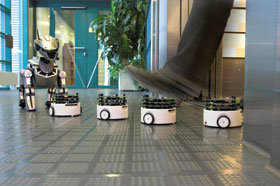

The world of robotics remains on the cutting edge of industrial technology, with various concepts emerging as disruptive agents in their respective markets. In recent years, technology advancements have overcome the limitations of robotic systems and, at the same time, the definition of robots has evolved.
Previous incarnations of industrial robots have been characterised by high price tags and significant integration requirements. However, an emerging class of robots stands in stark contrast to this model. These new robots have lower throughput; but provide the distinct advantage of being able to be co-located with human workers, cheaper to purchase, and requiring little or no integration or programming: this new breed of robots.
Cooperative robots for human assistance
Traditional industrial robotic solutions, such as those offered by ABB, Fanuc, Kuka, Mitsubishi Electric, or Yaskawa are efficient at doing specific, repetitious tasks very quickly in a high-volume environment. However, due to their speed and load capacity, these robots exert forces that prohibit operators from entering the work envelope. In contrast, robots such as those offered by Universal Robots and Rethink Robotics cannot compete with traditional robots based on ultimate speed or precision, but can work safely alongside humans, ungated.
These human-assisting robots are by design, low speed and low skill; but are able to perform cooperative tasks with human workers or work directly alongside them performing the same task, such as in pick-and-place applications. Due to their significantly lower prices and integration requirements, these robots are now viable options for small and medium-sized businesses with limited automation skills and budgets.
Autonomous mobile robots
In the mobile solutions space, robots are gaining traction against traditional AGV and fixed conveyor solutions. Along the spectrum of autonomy, there are a number of emerging solutions. These range from Kiva Systems’ coordinated robotic fleet to Seegrid’s driverless forklifts. While the Kiva solution is revolutionary for warehouse and distribution centres, the large capital investment in a fleet of codependent robots restricts its use to major corporations. In contrast, Seegrid’s solution is intended to allow for incremental investments and can be scaled to replace any number of forklifts with the company’s automated counterparts.
Reduced training requirements help expand market
ARC estimates that the combination of autonomous mobile robots and collaborative robots unit sales will exceed the unit sales of the traditional robotics market within the next five years.
This expansion of the robotics industry also increases acceptance of automation and new technology into previously untapped and sometimes more resistant or less skilled markets. A key selling point for these new classifications of robots is that they do not require significant integration, enabling users to be trained on these typically out-of-the-box solutions in a matter of days, as opposed to months.
Safety standard compliance
In the past, serious safety concerns related to having robots and humans working together in close proximity limited acceptance of this type of technology. However, the industry is rapidly embracing a more modern, effective safeguarding strategy that evaluates the use of equipment from a task-oriented perspective (ie, how the operator has to interact with the machinery). This task-oriented approach lends itself to the use of an integrated system solution that relies on intelligent automation components. This minimises the risk of operator injury to a tolerable level in specific operational modes of the machine, while allowing the operator to work more efficiently than would be possible using absolute safety measures such as physical guards and interlocks. Modern safety systems allow operators and maintenance personnel to gain access to an operating machine’s work zones by setting programmable limits on actuator speeds, forces, and torques to mitigate the risk of injury from these devices.
Studies performed in Sweden and Japan regarding robotic accidents further justify this modern approach to safety. These studies concluded that many robot-related accidents do not occur under normal operating conditions; but rather during programming, maintenance, repair, testing, setup, or adjustment. In most instances, work procedures required the operator or maintenance worker to temporarily enter the robot’s working envelope where unintended operations could result in injuries. Perimeter guarding or light curtains are temporarily overridden, exposing the worker to possible injury as he enters the work zone while the machine is still operational. In contrast, a modern safety approach respects the behaviour of factory personnel and implements safety solutions that allow safe access to work zones. This approach enables significant improvements in manufacturing productivity and expands the market for the new breed of robotic solutions.
The Robotics Industry Association is in the process of revising the ANSI/RIA R15.06 standard to recognise a class of robots defined as ‘collaborative robotic systems. To achieve this, the standard has adopted the safety standards developed for ISO 10218 in which risk assessment is graded on performance levels as outlined in the ISO 13849 machine safety standard.
Collaborative robot capabilities have been modified significantly to comply with the safety standards that address environments in which robots work in conjunction with humans. Speed, load, and task type for these new robots are quite different from their more traditional iterations. Lower speeds and lighter loads have reduced forces to within tolerable limits of the safety standards. In addition, bump sensors or vision sensors have been incorporated to avoid or mitigate collisions. The robots offered by Universal will stop motion when they come in contact with a foreign body, reducing the risk of serious injuries to an acceptable level.
Clearly, manufacturers can no longer simply regard robots as capable of performing only repetitive tasks. Today, they need to evaluate using robotics in applications than can benefit from dynamic decision making and autonomous behaviour. Mobile robotic costs relative to a fixed automation infrastructure will allow manufacturers to adapt more quickly to changing market conditions, significantly reducing risk.
For more information contact Paul Miller, ARC Advisory Group, +1 781 471 1126, [email protected], www.arcweb.com

© Technews Publishing (Pty) Ltd | All Rights Reserved